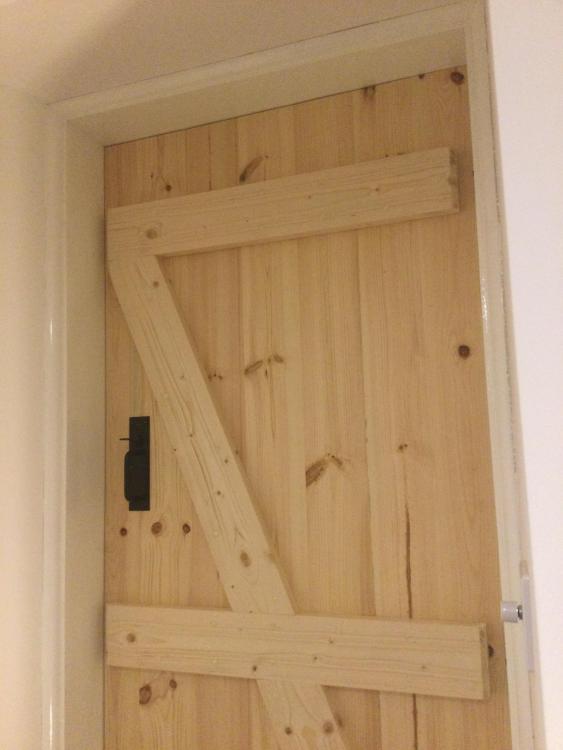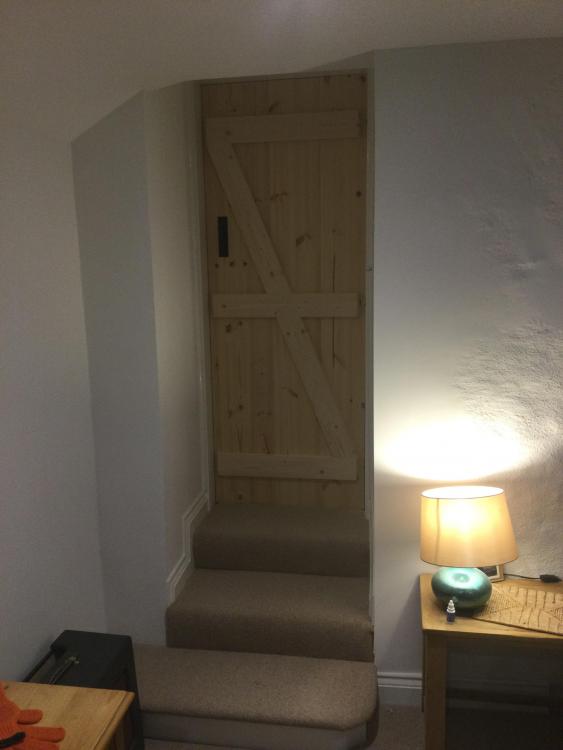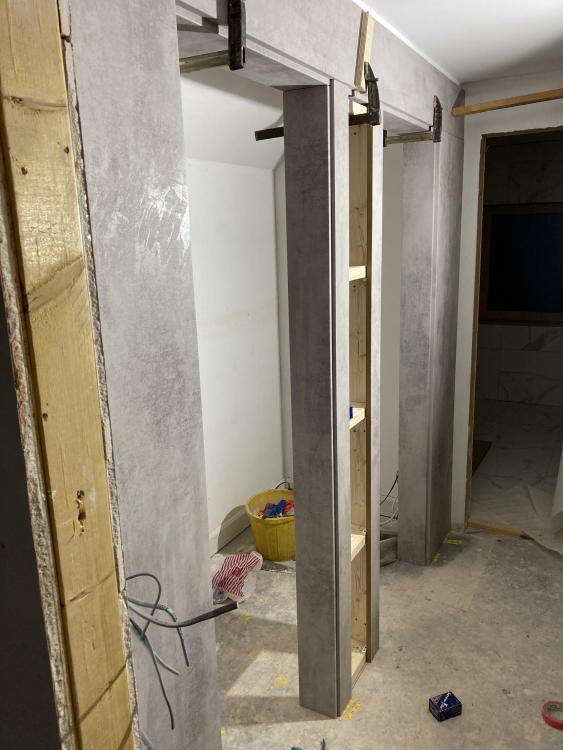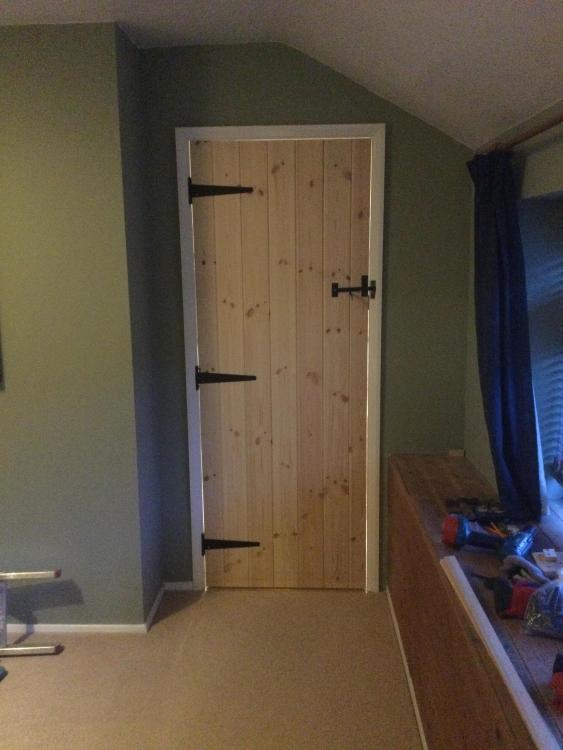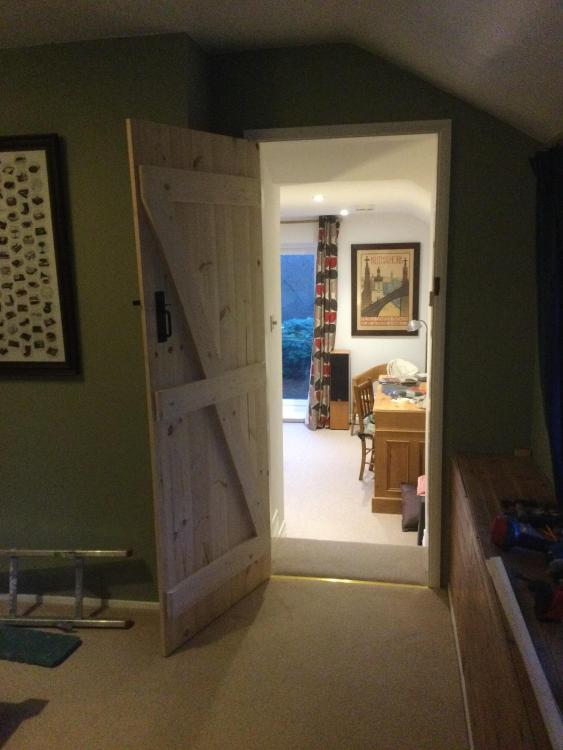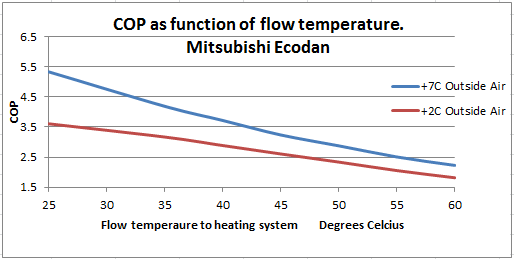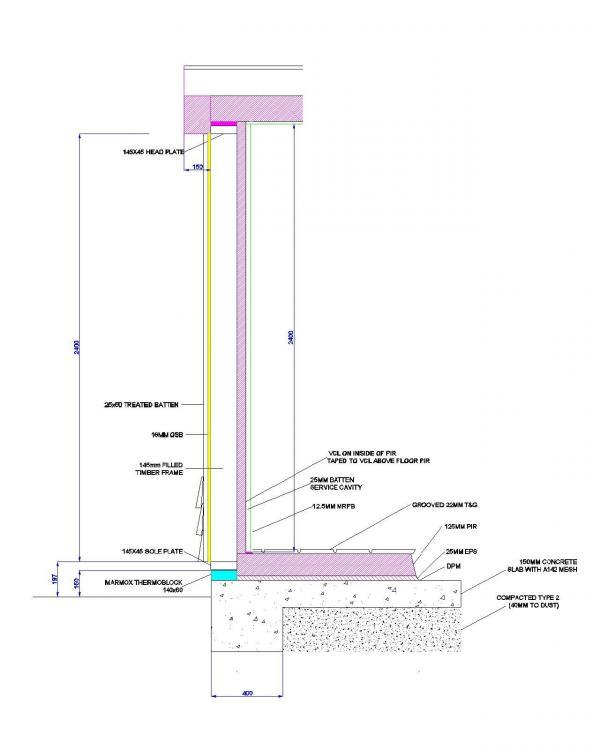Leaderboard
Popular Content
Showing content with the highest reputation on 01/29/21 in all areas
-
@Adsibob good well i did decide on three equal steps as you can see here.. and my door hung at last. Mm precision needed to do the hinges on frame 1 st.. tricky. Pesky plant ons to do, latch to chisel out on architrave/ far the easy bit. Its perfectly skimming carpet, perfect 3 mm gap around.. but ground floor doors swell and contract alarmingly, so if i get any of this happening im stuffed. But mm spot on as is, prolly a smidge too much tbh.5 points
-
Your architect needs a slap for coming up with such a poorly performing design that isn't even meeting minimum standards. Even though you'll be moving on in a few years, please bear in mind your house will be around for another 100 years or more. You should be aiming to blow through the SAP requirements, not scrape though. As above, make cavities 150mm wide, put in 150mm insulation in the floors, 400mm in the loft and consider higher performing windows and doors. And airtightness, makes a huge difference. It will of course add some cost to your build, but you'll have a much more comfortable house and a better legacy for the future.3 points
-
No, as long as you are sleeping OK. If the issue gets in the way of sleep, yes, you are. You might think that you are over-thinking: everyone does it. Yes even His Holiness @Russell griffiths . A while ago I got a bit p1$$ed off about how much I worried - I'm not a (so-called) Girl's Blouse either. So I wrote (2016) about it in my blog - (I used to train serving teachers and undergraduates) Of course you aren't experienced in PH building processes - yet. So you will think about it - share your worry, and we'll help. Ian3 points
-
The issue there is developer houses, built as cheap as possible, often to poor standards, and certainly with none of the measures we have been talking about like good insulation, good detailing, and things like mvhr.2 points
-
2 points
-
5 years is a long time and a lot could change by then. In terms of energy saving the lowest hanging fruits to improve on building regs are. 1.Triple Glazing 2. MVHR 3. Airtightness Added insulation is only an incremental gain in comparison. You could probably ditch the rads upstairs too in all but the bathrooms.2 points
-
Make the cavity 150mm and use blown beads. 100mm can no longer pass unless you use insulated plasterboard - your architect should know that. Ditch the jumbos with thin joint - they are expensive crap with expensive wall ties and brickies hate them. Go for a standard block and mortar.2 points
-
you could call it... a tap! ? @Dreadnaught you mention having to convince you’re M&E advisor on the merits of an alternative system to the hot return loop. Just TELL him that is what you’re having. You mention you’re using a Sunamp so you’re M&E advisor is clearly already comfortable with some less than conventional elements of your design so he should be able to manage an alternative to a hot return loop.2 points
-
You will be slower with thin joint and brick. 1. Thin joint uses glue, bricks use mortar. Your brickies will need to alternate between the two, and can’t “use up the last of the mix” on 15 blocks at the end of the day. 2. Wall ties take seconds to place and are cheap. Start using helical ties and you’re needing the tools plus they take time to install. They are about 10 times the price of standard ties too. Most BMs don’t stock thin joint glue so when you run out it’s another delay. 3. Labour doesn’t know what thin joint is in the UK. Expect a lot of waste, broken blocks and excessive use of materials - they are learning on your job and will be slow to start with. Coursing will need to be accurately managed, as will lintel placement. 4. Contractors price what they know. How many bricks and blocks they can lay in a day. They can do those calculations on the back of a Greggs bag ... new stuff they will guesstimate then add 20% for hassle factor. Thin joint isn’t your answer here ..!1 point
-
Just watched the latest episode and you are all a bit curmudgeonly. Pioneering spirit and a very nice and interesting house that ticked both of their boxes - albeit not sure what happened in the year or so in the middle.1 point
-
Hello WWilts. Sorry if I laid it on a bit thick there. You could look at timber frame. Design is an iterative process.. (I paraphrase - there are a number of better qualified members than I on BH) you start by listening to a Client's requirements, understand how they want to live now and in the future. A good designer will do a bit of "gaming".. what if you have more kids, what if you need to change jobs and want work from home etc, what are your aspirations.. energy use.. ( to use a cliche). Now as a designer you have an incling as to what the "soft" requirements are. To make this work within a budget it starts under the ground. It may seem a bit odd but if you go for the simple stupid option this can really knock a lot off the builder's price as the tender field is more open for example. I often think and see that folk have spent a lot of money on structure (and associated foundations / labour cost) creating a daft open span, or just the wrong span. Get the basics nailed early then you can then use this saving to upgrade insulation etc and also spend some money on.. heating controls/ rainfall showers and so on, some Farrow and Ball paint, stuff which you get to have fun playing with and can see every day. Remember that a house is not just to keep the weather out and you warm.. there is value in being able to play with it , adjust stuff up and down. Visitors only see the finished result.. not the insulation. There is no harm in showing what you have achieved. Wilts it may take a bit of work but go back and review from the foundations up and you may get a pleasant surprise.1 point
-
If it is air locked , and a there is a high probability of that, you really need to be considering putting a couple of auto-vents in on the high point of each loop, save the frustration of a repeat issue. Which will most likely cost more now, but save it going forward1 point
-
Consider the simple stupid. Roughly, as a ball park the labour cost on a new build is about a third for standard stuff, on a small extension this can easily touch 50%. (see R_Sole etc for good info) Some BH members are "in the trade" and can get a good discount and avoid the uplift due to complexity. But if you are starting out then maybe you want to make it easy to build. More local builders will be interested in pricing if it looks simple and they feel they can make a profit with less risk. The less risk they perceive the lower your price will often be. See what prices you get back with simple construction (avoid thin joints) then compare this with making it more complex.. remember that often you are working on a small scale unless you are a very wealthy Client. It's hard to do but you need to look at this in the round.. all the folk on your team should be pulling together. One big problem is that you often can't get a builder to price realistically without a descent spec.. it's catch 22. But starting with a simple spec can be attractive for a builder.. and once they are interested you can explore the cost of upping the spec. Good experienced designers will cost more but you get what you pay for and the really good ones will invest in you and give more than they take.. provided you pay their bill on time. To get the higher strength in a block you need more conductive material (density), less air.. air can't transmit load in this context. The thin joints offset this but you reduce your options regarding the builders who want to take the job on as they have to be much more accurate and this take time = extra cost. For me I would start with basic construction.. see how much that costs. Then you can start adding on the extra bells and whistles that appeal to you, energy saving etc, fire risk and so on. @Jason L"sorry, I'm just high jacking the tread for my house, i have a design SAP rating of A 93, with MVHR and i will try and make it super air tight, do you think I'm not going to need any heating on the first floor and in the attic bedroom, just towel rails in the shower rooms" Jason , it may be worthwhile having a chat with your designer about how the building is prevented from moving from left to right say (on the drawings) when the wind blows. You don't have too much on the ground floor to achieve structural stability by the looks of things. It may be a good idea to make sure you have a good handle on how the structure will work, then you can plan the services. If you don't do it this way then the saving on energy performance you think you make make may not be realised as you could end up with beams etc in the way of your ducts... sounds painful1 point
-
@Jason L , it is correct ?, it is roughly the basic elements of a Passivhaus build in our milder climate. N.B. it does not include about 2500kWh/yr for DHW!1 point
-
1 point
-
Probably because some people may want to use a system boiler and hot water cylinder with an immersion and use a diverter to maximise solar power to power the immersion... I don’t have room for a cylinder so that why I have a combi.1 point
-
We had panels cut to size here to make a wardrobe, everything cut to the exact size you want and doors pre drilled for hinges. It’s not skill-less to put it in but providing you measure accurately it all goes together with some basic chippy skills. Bits of it in the pic below. I’ll get a better one of it completed if you’re interested.1 point
-
1 point
-
Looking good mate, personally I hate doors that rattle, so if there is a little warp that means the door is tight when it’s shut that is a good thing, plus fir an old cottage things are allowed to be a little wonky!!! (Yes lost heads).1 point
-
You need a 'Full Overlay Plus' hinge in order to have a different thickness door and side panel with full coverage of the side panel edge.1 point
-
I spoke to land registry the other day and I was told that you can made a request to expedite applications.1 point
-
Thanks everyone for the feedback. I think I’ll end up with mounting the hinges inside which will leave about 9mm of the frame showing. I can live with that and plus it will give me a few mm extra before the open doors hit the loft ceiling.1 point
-
1 point
-
Forget the softwood timber deck. It will go crappy in a couple of years. Infill with hardcore and slab finish.1 point
-
Only if insulated properly and nicely air tight. I suspect this house might want some.1 point
-
1 point
-
1 point
-
Nice but lacks the adjustment a “kitchen” hinge gives but might be easier to fit ?1 point
-
Due to the higher temperature hurting the COP, ASHP's are less efficient for DHW than they are for heating. This is then exacerbated in cold weather when the COP falls further. In a well insulated house, DHW becomes a higher proportion of energy use which reduces the effective efficiency of an ASHP. If you look at the chart I put up earlier- You can see at 50C and 2C outside the COP isn't much above 2, whereas in the 35-40C range where you might run UFH it is around 3. From these figures an ASHP would cost around 3x as much to heat water as a gas boiler in the coldest days of winter. In summer when the temperature is in the 15-20 range the COP rises to between 4 and 5 and the penalty is much less. I am not sure that this quirk is well understood or advertised. ASHP works far better with low UFH flow temp and if you don't want your hot water to be too hot, 48C seems to be the recommended hot water temperature.1 point
-
Electric boilers only make sense if you can run them on a cheap off peak tariff. Economy 10 makes quite a bit of sense as you can put most of the heating load onto the cheap rate. But a MUCH better idea for all electric heating is a heat pump. If gas is available it will be the cheapest option no doubt about that.1 point
-
+1 You can aim for better air tightness but I wouldn't rely on achieving it.1 point
-
Mould growth is a result of cold walls (poor insulation) and condensation forming. Not helped by poor ventilation leaving moist stale are lingering. I don't expect you have this problem with ANY modern method of building with a decent level of insulation and importantly with everything well detailed. Then add mvhr to ensure fresh eficcient clean dry air and the chance of mould is nil,.1 point
-
Changing to Dritherm 32 could make more carbon savings than adding 100mm to loft insulation if walls have greater m2 than roof and improve wall U-value to about 0.241 point
-
And aim for an air test of much better than 4.0. Detail it properly and get a much lower actual air test value. Are you fitting mvhr? What do you want from the house? A really comfortable house that needs very little heating, or as cheap as possible build to just scrape through building regs and have higher heating costs?1 point
-
what window and door spec have you got? If they're are big areas of glass bringing the uvalue down on those would give you a good boost on sap heating system is somewhere else to look, walls give you an incremental increase but how far is it failing?1 point
-
CH. some progress. All rads bled/ fine. Done a 'rough balance' turning down few rads, to help push heat on to my top bedroom. Another call.. & deep in installer section the thermostat wasn't engaged/ so reset, seems ok! (Relief: the last visit young guy up from swansea said "ive just had covid, nothing to worry about" half into visit. ! Chaps from all over UK for these visits was concerning me prior to this.. so relieved visit no.10 avoided). So my approx balance, plus tweaks of: undoing a default "noise reduction" mode (letting it run free as it were), & upping heat curve to 1.5 (was 1.2 before, and 0.8 on install).. whether all responsible I don't know, but new top room temp - seems- better. It is very mild tho. So proof will be coming cold snap. Then if needed, I can do a more specific balance. But still not understanding 'lockshield'. Im not clear if i have one or two on each rad, or none at all. What i have afaict, is simply one of these, on each side of all rads: ( screwfix 33920 ). thx zoot.1 point
-
I'm NOT saying do so at all but a little embellishment you can make with these doors is to run a router around the edges of the ledges and braces. Rounds the edge over and saves you catching your arm, hip etc as you brush by.1 point
-
1 point
-
1 point
-
Are you sure it’s not running down from above?, that joint is above the water level In the trap (try a smear of Vaseline on the blue bit).1 point
-
Are you sure you’ve thought this through? Looks a bit amateur-ish to be honest.1 point
-
Bathrooms are not included in this as they are not habitable rooms Check the definitions Habitable room A room used, or intended to be used, for people to live in (including, for the purposes of Approved Document B Volumes 1 and 2, a kitchen, but not a bathroom).1 point
-
1 point
-
Think I suggested feeding the cistern with hot water. I've had this set up for 10years in my bathroom. It's a TMV fitted after the hot spur to the basin tap, TMV set at around 25-30⁰ (basically water in a hot summers day) When you repeatedly flush the toilet the water in the cistern is best described as tepid. I get no condensation and the water you'd normally waste down the sink is mostly eliminated. I intend to do the same in the kitchen on the feed to appliances, to speed up hot water availability at the tap as the kitchen is a long way from UVC and it reduce cycle times of the appliances + cost of heating the water with gas v's electricity is cheaper1 point
-
I got some Domas DDseal from my electrical wholesaler without too much trouble. If memory serves it seemed to be the only thing that was specifically quoted as being suitable for PVC and metal. Other products I found only referred to metal ducting.1 point
-
No it is not a new house. It is a 1910 period property. I am just doing renovations to it.1 point
-
1 point
-
If you were closer, you’d be welcome to plenty of it. It grows on the bank of the stream that run alongside my garden.1 point
-
Sansco from Amazon hard disk unit stick it in the electricity cupboard and cable away to the 2megapixelmcamera cheap as Chips and works perfectly1 point
-
I find the illbruck products very good and have a good range of products! https://www.toolden.co.uk/sealants-adhesives/expanding-foams/expanding-foams-professional-diy/illbruck-fm310-pro-gun-foam-pack-of-12/1 point
This leaderboard is set to London/GMT+01:00



